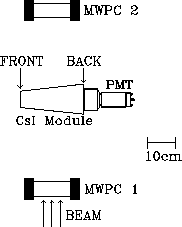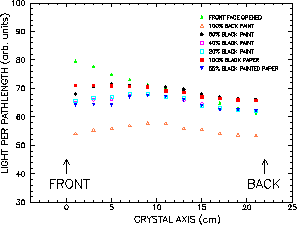



Next: Cosmic Ray Tomography
Up: Performance and Calibration
Previous: Performance of the
The effects of various surface treatments on the light output and the light
collection uniformity have been studied during the test of 1993 with the
objective of finding the wrapping material and method which maximize the light
output and at the same time minimize the light collection non-uniformity
along
the axis of the calorimeter modules.

Figure: The
set-up for
light output and light collection uniformity tests. The
wrapped CsI module was sandwiched between two MWPC's. A parallel beam of pions
of 375 MeV/c traversed the first chamber, the CsI module and the second
Chamber. The active areas of the chambers were not big enough to cover the
entire body of the CsI crystal. As a result, for a given wrapping system, data
were taken in a set of runs during which the CsI module was translated
perpendicularly to the beam with the MWPC's held fixed.
During these studies one calorimeter module was used
and its lateral surfaces were wrapped with different material such as teflon,
aluminized mylar, etc. In addition, the front surface of the crystal was covered
with black paint ( or less), black paper or simply left naked. Different
layers of wrapping were also considered. For each wrapping system, the dressed
crystal was taken into the beam line, flanked by two rectangular MWPC's as
illustrated in figure
or less), black paper or simply left naked. Different
layers of wrapping were also considered. For each wrapping system, the dressed
crystal was taken into the beam line, flanked by two rectangular MWPC's as
illustrated in figure  . The
CsI crystal and the MWPC's were arranged perpendicularly to the central
trajectory of the beam. A parallel beam of pions of
. The
CsI crystal and the MWPC's were arranged perpendicularly to the central
trajectory of the beam. A parallel beam of pions of  passed
through the
first MWPC, traversed the calorimeter module and went through the second MWPC.
The two MWPC's were the same ones used earlier during the run for the beam
studies (see figure 3.6). Each of the MWPC's had an active area of
passed
through the
first MWPC, traversed the calorimeter module and went through the second MWPC.
The two MWPC's were the same ones used earlier during the run for the beam
studies (see figure 3.6). Each of the MWPC's had an active area of
 and consisted of sixty-four vertical and
sixty-four horizontal wires.
and consisted of sixty-four vertical and
sixty-four horizontal wires.
Two
quantities were extracted from the hits in the MWPC's and the CsI modules: the
light output of the CsI due to a beam pion which traversed the module and the
path length of that pion in the CsI module. The purely geometrical
effects on the light collection non-uniformity as a result of the tapered
pyramidal shapes of the module were eliminated by taking the ratio of the
light output to the pathlength. The light output was given by the ADC read out
while the pathlength was obtained as follows: The MWPC's provided two points
 and
and  , indicating where the
, indicating where the  entered the two
chambers. Therefore, these points gave the trajectory of the beam
entered the two
chambers. Therefore, these points gave the trajectory of the beam  , a
trajectory which necessarily passed through the CsI crystal since the module
was in the trigger. The segment of this line within the CsI was the pathlength.
Only the tracks with minimal divergence as a result of multiple scattering in
the CsI were selected for the calculation of the pathlength which could be
obtained with different methods.
, a
trajectory which necessarily passed through the CsI crystal since the module
was in the trigger. The segment of this line within the CsI was the pathlength.
Only the tracks with minimal divergence as a result of multiple scattering in
the CsI were selected for the calculation of the pathlength which could be
obtained with different methods.

Figure: The light output
per unit pathlength along the axis of the crystal for
different treatments of the front face. Among all the treatments considered,
black paper gave the most uniform response and the best light output. For
these treatments of the front face, the lateral surfaces were covered with
three layers of teflon. The result of these tests was used in the subsequent
measurements of the responses of an array of twelve modules to monoenergetic
beams of  's.
's.
One method used during the on-line data taking relied
on the knowledge of the tapered angles of the surfaces of entrance and exit of
the  . During the course of the off-line analysis the pathlengths were
calculated in a Fortran routine which defined the calorimeter modules as a
volume bound by intersecting planes. The routine also positioned the module
as it was in the beam and found the intersection points of the line defined
by the hits
. During the course of the off-line analysis the pathlengths were
calculated in a Fortran routine which defined the calorimeter modules as a
volume bound by intersecting planes. The routine also positioned the module
as it was in the beam and found the intersection points of the line defined
by the hits  and
and  with the planes of entrance and exit.
The distance between these intersection points was returned as the pathlength.
The active length (12.8 cm) of the MWPC's could not cover the entire body of
the module (22 cm). For this reason, for a given wrapping material and method,
data were taken in a series of runs during which the CsI crystal was translated
perpendicularly to the beam with respect to the fixed positions of the MWPC's.
with the planes of entrance and exit.
The distance between these intersection points was returned as the pathlength.
The active length (12.8 cm) of the MWPC's could not cover the entire body of
the module (22 cm). For this reason, for a given wrapping material and method,
data were taken in a series of runs during which the CsI crystal was translated
perpendicularly to the beam with respect to the fixed positions of the MWPC's.
Figure  shows the light output per unit pathlength along the
axis of the modules for various treatments of the front face: the lateral
faces were wrapped in three layers of teflon. Better uniform response and
light output were achieved with the front face covered with black paper.
Consequently, for the study of the responses of an array of calorimeter
modules to monoenergetic positron beams, each crystal was wrapped in three
layers of teflon with black paper at the front face.
shows the light output per unit pathlength along the
axis of the modules for various treatments of the front face: the lateral
faces were wrapped in three layers of teflon. Better uniform response and
light output were achieved with the front face covered with black paper.
Consequently, for the study of the responses of an array of calorimeter
modules to monoenergetic positron beams, each crystal was wrapped in three
layers of teflon with black paper at the front face.
Further tests regarding the surface treatment of the crystals were carried
out after the run of 1993. These tests favored a wrapping method
consisting of one layer of aluminized mylar in addition to the three layers of
teflon on the lateral surfaces and black paper of the front faces. Furthermore,
a tomography
apparatus has been set-up to examine the optical properties of
each of the calorimeter modules with minimum ionizing cosmic muons. The
apparatus and some of its results are presented next.




Next: Cosmic Ray Tomography
Up: Performance and Calibration
Previous: Performance of the
Bernward Krause
Mon Jan 15 14:57:06 MET 1996





 or less), black paper or simply left naked. Different
layers of wrapping were also considered. For each wrapping system, the dressed
crystal was taken into the beam line, flanked by two rectangular MWPC's as
illustrated in figure
or less), black paper or simply left naked. Different
layers of wrapping were also considered. For each wrapping system, the dressed
crystal was taken into the beam line, flanked by two rectangular MWPC's as
illustrated in figure 
 passed
through the
first MWPC, traversed the calorimeter module and went through the second MWPC.
The two MWPC's were the same ones used earlier during the run for the beam
studies (see figure 3.6). Each of the MWPC's had an active area of
passed
through the
first MWPC, traversed the calorimeter module and went through the second MWPC.
The two MWPC's were the same ones used earlier during the run for the beam
studies (see figure 3.6). Each of the MWPC's had an active area of
 and consisted of sixty-four vertical and
sixty-four horizontal wires.
and consisted of sixty-four vertical and
sixty-four horizontal wires.
 and
and  , indicating where the
, indicating where the  entered the two
chambers. Therefore, these points gave the trajectory of the beam
entered the two
chambers. Therefore, these points gave the trajectory of the beam  , a
trajectory which necessarily passed through the CsI crystal since the module
was in the trigger. The segment of this line within the CsI was the pathlength.
Only the tracks with minimal divergence as a result of multiple scattering in
the CsI were selected for the calculation of the pathlength which could be
obtained with different methods.
, a
trajectory which necessarily passed through the CsI crystal since the module
was in the trigger. The segment of this line within the CsI was the pathlength.
Only the tracks with minimal divergence as a result of multiple scattering in
the CsI were selected for the calculation of the pathlength which could be
obtained with different methods.

 's.
's. . During the course of the off-line analysis the pathlengths were
calculated in a Fortran routine which defined the calorimeter modules as a
volume bound by intersecting planes. The routine also positioned the module
as it was in the beam and found the intersection points of the line defined
by the hits
. During the course of the off-line analysis the pathlengths were
calculated in a Fortran routine which defined the calorimeter modules as a
volume bound by intersecting planes. The routine also positioned the module
as it was in the beam and found the intersection points of the line defined
by the hits  and
and  with the planes of entrance and exit.
The distance between these intersection points was returned as the pathlength.
The active length (12.8 cm) of the MWPC's could not cover the entire body of
the module (22 cm). For this reason, for a given wrapping material and method,
data were taken in a series of runs during which the CsI crystal was translated
perpendicularly to the beam with respect to the fixed positions of the MWPC's.
with the planes of entrance and exit.
The distance between these intersection points was returned as the pathlength.
The active length (12.8 cm) of the MWPC's could not cover the entire body of
the module (22 cm). For this reason, for a given wrapping material and method,
data were taken in a series of runs during which the CsI crystal was translated
perpendicularly to the beam with respect to the fixed positions of the MWPC's.